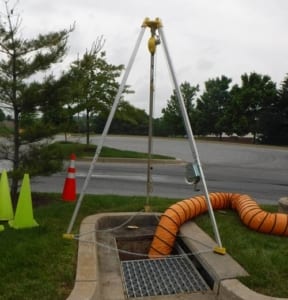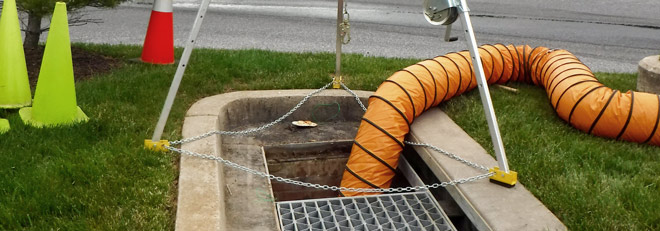Confined Space Entry (CSE) Equipment & Methods
As a designer-builder-operator of water and wastewater systems, Hydro-Terra Group (HTG) benefits from the use of confined space entry (CSE) equipment and methods for the safe and effective execution of a variety of tasks.
In the past few months, HTG was required to employ these tools and procedures for sub-grade stormwater facility inspection, below grade wastewater process construction, and process industrial water pretreatment tank entry and modification. Without such equipment and training, HTG personnel could not conduct such work safely and our capabilities would be significantly limited.
But what is CSE? The Occupational Safety and Health Administration (OSHA) defines confined spaces as those that “are not necessarily designed for people, [and] are large enough for workers to enter and perform certain jobs. A confined space also has limited or restricted means for entry or exit and is not designed for continuous occupancy. Confined spaces include, but are not limited to, tanks, vessels, silos, storage bins, hoppers, vaults, pits, manholes, tunnels, equipment housings, ductwork, pipelines, etc.” Furthermore, “permit-required confined spaces” are those that have “one or more of the following characteristics: contains or has the potential to contain a hazardous atmosphere; contains material that has the potential to engulf an entrant;  has walls that converge inward or floors that slope downward and taper into a smaller area which could trap or asphyxiate an entrant; or contains any other recognized safety or health hazard, such as unguarded machinery, exposed live wires, or heat stress.” CSE involves the use of OSHA-stipulated equipment and methods for safely entering such spaces and conducting necessary work. OSHA training courses and the correct equipment and procedures are necessary for safe execution of our many tasks.
has walls that converge inward or floors that slope downward and taper into a smaller area which could trap or asphyxiate an entrant; or contains any other recognized safety or health hazard, such as unguarded machinery, exposed live wires, or heat stress.” CSE involves the use of OSHA-stipulated equipment and methods for safely entering such spaces and conducting necessary work. OSHA training courses and the correct equipment and procedures are necessary for safe execution of our many tasks.
The primary goal of employing CSE equipment is to maintain a safe working environment, utilizing engineering controls, good communication, and process fail-safes. Historically, the primary cause of confined space deaths are attributed to hazardous atmospheres in enclosed spaces. A typical scenario is that one worker falls unconscious due to the lack of oxygen, a second enters to try to rescue with no retrieval system and also falls unconscious, and so on until someone stops the domino effect. Other common casualties have been documented in excavation cave-ins, where workers were partially or completely engulfed in loose soil, causing injury and death. These are only a couple of examples of unsafe entry into a confined space which resulted in fatal consequences.
Much of the CSE work we do centers around entering subterranean tanks. After careful planning, developing the permit (identify personnel, gather safety materials, generate an emergency action plan) and having the correct tools on site, the first step is to always check the atmosphere for hazardous conditions (low oxygen, explosive vapors, etc.) and set up the retrieval system (e.g. tripod with fall arrestor and harness). Ventilation or supplemental breathing measures are also key for establishing a reliable safe atmosphere for workers to be entering. When the Entrant enters the confined space, the Attendant stays with him or her the entire time, monitoring the air space, communicating with the Entrant, and being prepared to retrieve the Entrant should they stop responding.
With the proper training and our growing field experience, this process is manageable and fluid, and ensures we can reliably get the job done while ensuring safety for all those involved. Should you have any questions or needs for CSE services, please contact Hydro-Terra Group at (410) 861-5376 or (717) 980-5150.

